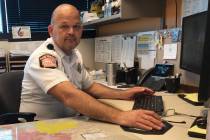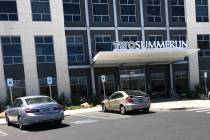Artificial flora experiment has roots in cost saving
Maybe you haven’t noticed the artificial flora that have replaced the real McCoy on the median islands along a two-mile stretch of Rampart Boulevard. Or maybe it’s just that you never realized the difference.
The cactuses and other forms of desert shrubbery that serve as the roadway divider, stretching from Lake Mead Boulevard to Cheyenne Avenue, are now artificial reproductions of plant life, cast from metal. And they’re entrenched amid a fresh layer of rocks to give the entire area a true Southwestern motif.
It has been that way for more than a year. And on the basis of appearance and cost savings, the new look already has been declared a winner by the Las Vegas City Council, so much so that it appropriated $1 million to carry the experiment into all six wards of the city.
So whose truly bright idea was this?
For one thing, it’s the product of a leisurely drive that Ward 4 Councilman Stavros Anthony said he takes periodically through his ward, “looking to see what we can do to make my ward, as well as the rest of Las Vegas, look even greater.”
For another thing, Anthony said he came up with the idea of using artificial flora to replace the real thing as a means of saving money. And that, indeed, was the factor that turned the Rampart “experiment” into a model for expansion.
Add to that the amount of positive feedback the city has received from the rebuilt Rampart Boulevard median, and just the one leisurely drive Anthony took around his ward has the potential to save even bigger bucks than first believed.
“Look at it this way: We don’t have to water the artificial plants and rocks that now form this new Southwestern motif along the Rampart median,” Anthony said. “Overall, the upkeep is minimal. In fact, the only maintenance is the periodic removal of any trash that is bound to accumulate.”
That means no road crews creating traffic jams by placing those long lines of orange cones to block off entire road lanes while workers trim, shape and often must replace dead shrubbery in the medians —- a task that occurs a few times a year. Add to that the growing cost of water in a city that has suffered for more than a decade from a severe drought, and you begin to see the advantages of fabricated cactuses and other flora in road medians.
“When we have to install new water to a median, it usually costs around $25,000,” said city spokesman Jace Radke. “That’s in addition to the use of thousands of gallons of water a year to keep the plants alive.”
Of course, with artificial reproductions of the same plants, the city’s water bill can be reduced dramatically.
“Some of the artificial plants for Rampart Boulevard were made by city employees, which further minimized the cost,” Anthony said. “And, obviously, once a plant is cast and welded into place, it becomes a permanent fixture.” All the work in redesigning and implementing the new Rampart median was done by the city’s Public Works Department.
The entire cost of the project was $95,000, according to Radke. What began admittedly as an experiment “has turned into a project that is both aesthetically and economically practical,” Anthony said.
He explained that implementation of a second artificial median already is under way in Ward 4 on Cheyenne Avenue from Rampart Boulevard west to Hualapai Way. The two-mile stretch along the northwestern perimeter of Summerlin has been budgeted to cost $100,000 of the $1 million appropriation from the council.
Radke said six other median projects are on the drawing board, including two in Ward 1, involving Decatur and Upland boulevards, each at an estimated cost of $100,000. One project in Ward 2 involves Charleston Boulevard, at an estimated cost of $400,000. A project in Ward 3 involving Eastern Avenue is estimated at $100,000. One project in Ward 5, along Decatur Boulevard, is estimated at $100,000. And a project in Ward 6, along Ann Road, also is estimated at $100,000.
Herb Jaffe was an op-ed columnist and investigative reporter for most of his 39 years at the Star-Ledger of Newark, N.J. He is the author of the novels “Falling Dominoes” and “One At A Time.” Contact him at hjaffe@cox.net.












